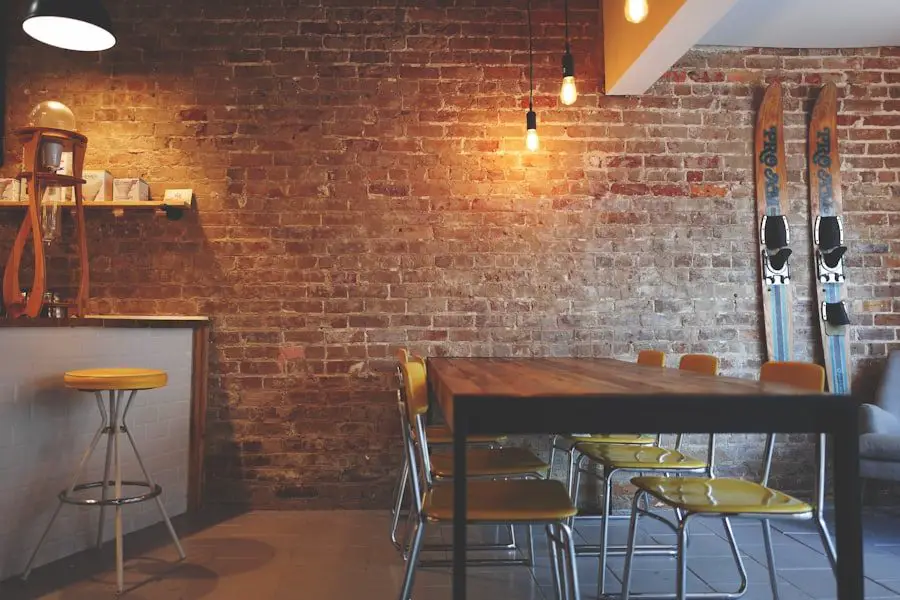
Cafe culture is a long-standing global tradition that brings people together over coffee or tea. This social experience transcends borders and has become integral to many societies worldwide. Cafe culture encompasses not only the beverages served but also the atmosphere, conversations, and sense of community fostered within these establishments.
The concept has manifested in various forms across different regions, including European coffee houses, Asian tea houses, South American social cafes, African urban cafes, and North American specialty coffee shops. Each of these expressions reflects the unique cultural context and social norms of its respective location. The evolution of cafe culture has been shaped by historical, economic, and social factors, resulting in a diverse range of experiences and traditions.
As this global phenomenon continues to evolve, new trends and innovations are emerging, influencing the future of cafe culture and its role in society.
Key Takeaways
- Cafe culture is a global phenomenon that encompasses a wide range of traditions and practices related to socializing and enjoying beverages.
- European cafe culture is deeply rooted in the tradition of coffee and conversation, with cafes serving as important social hubs in many communities.
- Asian cafe culture includes both traditional tea houses and modern coffee shops, providing spaces for relaxation and social interaction.
- South American cafe culture emphasizes the importance of socializing and savoring beverages, often with a focus on local and traditional ingredients.
- African cafe culture has evolved from traditional brews to urban cafes, reflecting a blend of traditional and modern influences.
European Cafe Culture: A Tradition of Coffee and Conversation
The Art of Conversation and Leisure
The European cafe culture is characterized by its relaxed and leisurely atmosphere, where people can spend hours sipping their favorite brew, reading newspapers, playing chess, or simply people-watching. In countries like Italy, the cafe is not just a place to grab a quick espresso, but a central part of daily life where locals gather to socialize and enjoy the ritual of coffee drinking.
A Space for Connection and Community
The cafe is seen as a place where people can escape the hustle and bustle of daily life and engage in meaningful interactions with friends, family, or even strangers. It is a space where people can come together to share ideas, debate issues, or simply enjoy each other’s company in a relaxed and welcoming environment.
Unique Customs and Traditions
The European cafe culture has also given rise to unique customs and traditions, such as the French “cafe gourmand” which pairs coffee with small sweet treats, or the Italian “aperitivo” where patrons can enjoy complimentary snacks with their drinks during happy hour. These customs reflect the importance of food and drink in European cafe culture as a way to enhance social connections and create a sense of conviviality.
Asian Cafe Culture: Tea Houses and Modern Coffee Shops

In contrast to the European coffee house tradition, Asian cafe culture has its roots in tea houses that have been an integral part of the region’s social fabric for centuries. In countries like China, Japan, and Korea, tea houses have served as gathering places for people to relax, socialize, and partake in traditional tea ceremonies that are steeped in ritual and symbolism. These tea houses are often serene and tranquil spaces that offer a respite from the chaos of urban life, where patrons can enjoy a wide variety of teas while engaging in quiet conversation or meditation.
In recent years, however, modern coffee shops have also gained popularity in Asia, especially among the younger generation who are drawn to the trendy ambiance and specialty coffee offerings. Asian cafe culture is characterized by its emphasis on mindfulness and the appreciation of nature, which is reflected in the design and aesthetics of many tea houses and modern coffee shops. These establishments often feature minimalist decor, natural materials, and serene outdoor spaces that create a sense of harmony and tranquility.
In countries like Japan, there is also a strong emphasis on hospitality and customer service, with baristas and tea masters who are highly skilled in their craft and take pride in creating a memorable experience for their patrons. Asian cafe culture is not just about the beverage itself, but also about creating a holistic sensory experience that engages all the senses and promotes a feeling of well-being.
South American Cafe Culture: Socializing and Savoring
| Country | Coffee Consumption per capita (kg/year) | Number of Cafes | Popular Coffee Drinks |
|---|---|---|---|
| Argentina | 2.3 | 5,000 | Espresso, Cortado, Submarino |
| Brazil | 6.0 | 21,000 | Cafézinho, Cappuccino, Galão |
| Colombia | 2.2 | 15,000 | Tinto, Cappuccino, Aguardiente |
| Peru | 1.6 | 3,000 | Café Americano, Espresso, Macchiato |
South American cafe culture is deeply rooted in the concept of “sobremesa,” which refers to the leisurely time spent lingering at the table after a meal, savoring coffee or mate (a traditional South American caffeine-rich infused drink), and engaging in conversation with friends and family. In countries like Argentina and Brazil, cafes are vibrant social spaces where people come together to relax, socialize, and enjoy the simple pleasures of life. The South American cafe culture is characterized by its warm and convivial atmosphere, where patrons can spend hours chatting with friends or watching passersby while sipping on their favorite beverages.
In addition to being social hubs, South American cafes also play a significant role in preserving cultural traditions and rituals related to coffee and mate consumption. In Argentina, for example, the “cafe con leche” (coffee with milk) is a beloved morning ritual that is often accompanied by sweet pastries or toasted bread with jam. In Brazil, the “cafezinho” (small coffee) is a strong and sweet espresso that is typically served throughout the day as a way to energize and socialize with others.
South American cafe culture is also known for its live music performances, tango dancing, and art exhibitions that add to the overall sensory experience of visiting a cafe. Whether it’s enjoying a leisurely afternoon “merienda” (snack) in Buenos Aires or sipping on “terere” (cold mate) in Paraguay, South American cafe culture embodies the spirit of community and celebration.
African Cafe Culture: From Traditional Brews to Urban Cafes
African cafe culture is as diverse as the continent itself, with each region boasting its own unique traditions and customs related to coffee consumption. In countries like Ethiopia and Eritrea, coffee holds a special significance as it is believed to have originated in this region and is often prepared using traditional methods such as roasting the beans over an open flame and brewing them in a clay pot called a “jebena.” The coffee ceremony in Ethiopia is a time-honored ritual that symbolizes hospitality and community, where friends and family gather to share stories and bond over multiple rounds of freshly brewed coffee. In urban centers across Africa, modern cafes have also become popular gathering places for young professionals, students, and expats who are drawn to the vibrant energy and cosmopolitan vibe of these establishments.
African cafe culture is characterized by its fusion of traditional and contemporary elements, with many cafes offering a mix of local brews alongside international coffee blends and specialty drinks. In cities like Nairobi, Cape Town, and Lagos, cafes have become hubs for creativity and innovation, hosting art exhibitions, poetry readings, and live music performances that showcase the rich cultural diversity of the continent. African cafe culture is also evolving to embrace sustainability and ethical sourcing practices, with many cafes partnering with local farmers and cooperatives to support fair trade principles and promote economic empowerment within their communities.
North American Cafe Culture: The Rise of Specialty Coffee

The Rise of Specialty Coffee
The third wave coffee movement has revolutionized the way people perceive and consume coffee in countries like the United States and Canada, with an emphasis on single-origin beans, artisanal roasting techniques, and creative brewing methods such as pour-over, cold brew, and nitro coffee. Specialty coffee shops have become destinations for coffee aficionados who seek out unique flavor profiles and are willing to pay a premium for ethically sourced beans that support small-scale farmers around the world.
A Hub for Community and Culinary Delights
In addition to serving exceptional coffee, North American cafes have also become community hubs that offer a range of culinary delights including gourmet pastries, artisanal sandwiches, and locally sourced snacks. Many cafes also prioritize sustainability by using eco-friendly packaging, implementing recycling programs, and supporting environmental initiatives that reduce their carbon footprint.
A Culture of Technology and Community
North American cafe culture is also known for its emphasis on technology and digital connectivity, with many cafes offering free Wi-Fi access, USB charging stations, and cozy workspaces for remote workers or students. Whether it’s enjoying a handcrafted latte in a hipster cafe in Portland or savoring a cold brew on-the-go in New York City, North American cafe culture reflects a passion for quality, creativity, and community.
The Future of Cafe Culture: Trends and Innovations
The future of cafe culture is shaped by ongoing trends and innovations that are redefining the way people experience coffee and tea around the world. One major trend is the growing demand for plant-based alternatives such as oat milk, almond milk, and coconut milk that cater to consumers who are seeking dairy-free options for their beverages. Many cafes are also embracing sustainable practices by reducing waste through compostable cups, biodegradable straws, and reusable containers that minimize environmental impact.
Another trend that is shaping the future of cafe culture is the integration of technology into the customer experience through mobile ordering apps, contactless payment systems, and digital loyalty programs that enhance convenience and efficiency. Virtual coffee tastings, online brewing classes, and interactive workshops are also becoming popular ways for cafes to engage with their customers beyond the physical space. In terms of design and ambiance, future cafes are expected to prioritize open-air spaces, rooftop gardens, and natural light to create inviting environments that promote well-being and connection with nature.
The concept of “slow cafes” is also gaining traction as an antidote to fast-paced urban life, offering patrons a chance to unplug from technology and savor their beverages mindfully. Overall, the future of cafe culture is evolving to embrace diversity, sustainability, innovation, and inclusivity as it continues to be a cherished tradition that brings people together over shared moments of joy and connection.
If you’re a fan of unique and exotic flavors, you’ll love learning about the Korean citrus delight known as yuja hwachae. This refreshing and tangy drink is a popular choice in Korean cafes, and you can discover more about it in this article on Flavorful Sips. And if you’re in the mood for something spicy, check out their guide to spicy cake recipes. Or, if you’re feeling adventurous, you can unearth the mystery of the cactus pear and learn about its culinary uses. Flavorful Sips has a wealth of information on unique and delicious drinks and ingredients from around the world.
FAQs
What is a cafe?
A cafe is a type of restaurant that typically serves coffee, tea, light meals, and snacks. It is a place where people can gather to socialize, work, or relax in a casual setting.
What are the different types of cafes around the world?
There are various types of cafes around the world, including traditional coffeehouses, modern specialty coffee shops, internet cafes, and themed cafes such as cat cafes, board game cafes, and more.
What are some popular cafe cultures around the world?
Some popular cafe cultures around the world include the traditional coffeehouse culture in Vienna, the specialty coffee culture in cities like Portland and Melbourne, and the vibrant cafe scene in cities like Paris and Tokyo.
What are some common menu items found in cafes?
Common menu items found in cafes include coffee drinks such as espresso, cappuccino, and latte, as well as tea, pastries, sandwiches, salads, and light breakfast items.
How do cafes contribute to the local community?
Cafes often serve as gathering places for locals to socialize, work, or relax. They also contribute to the local economy by providing employment opportunities and attracting visitors to the area. Additionally, cafes may support local farmers and suppliers by sourcing ingredients locally.



